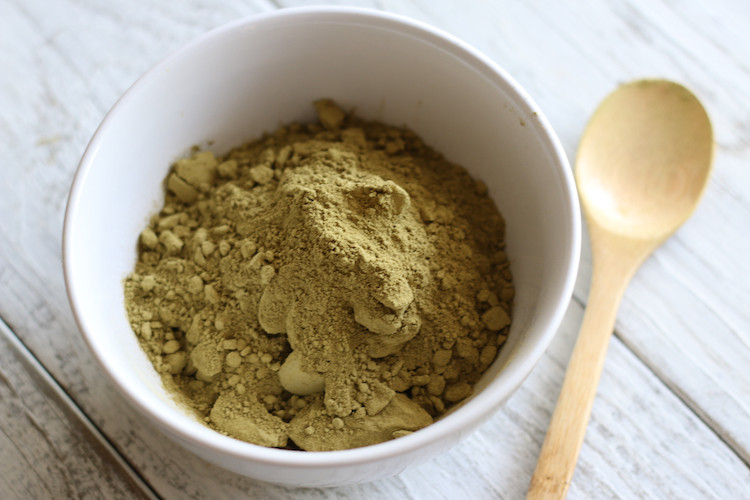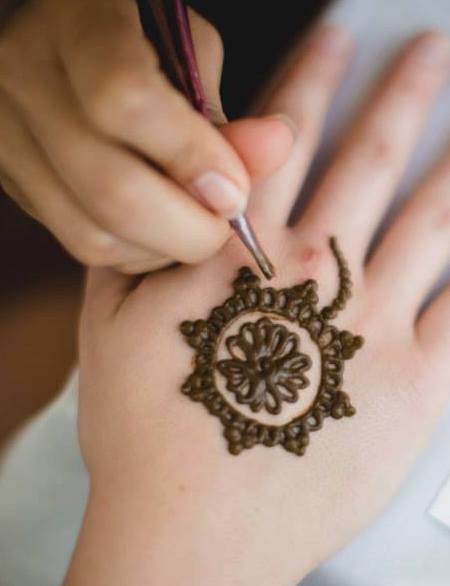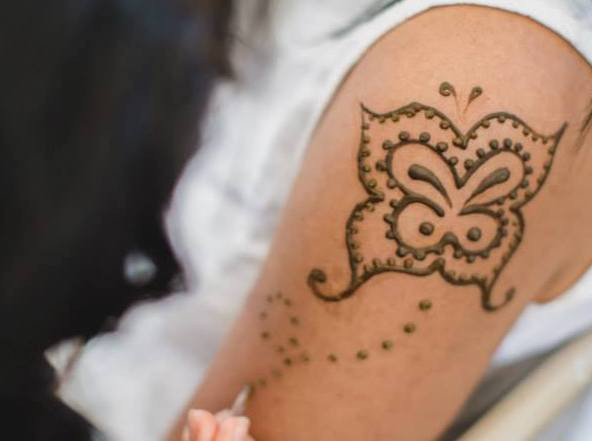Can You Use Henna Hair Dye For Tattoos? Absolutely not; using henna hair dye for tattoos can lead to severe skin reactions and permanent scarring. At tattooat.com, we’re dedicated to guiding you toward safe and stunning body art experiences; explore authentic temporary tattoos instead.
1. What Is Henna and How Is It Used?
Henna is a dye prepared from the Lawsonia inermis plant, also known as the henna tree. It has been used for centuries for body art and hair coloring, mainly in regions of South Asia, the Middle East, and Africa. The leaves of the henna plant contain a dye molecule called lawsone, which binds to proteins, resulting in staining.
- Traditional Uses: Henna has cultural and ceremonial importance, often used in weddings and festivals.
- Hair Dye: Henna coats the hair shaft, adding color without deeply penetrating it, making it a natural alternative to chemical dyes.
- Temporary Tattoos: Henna is applied to the skin in intricate designs, staining the epidermis and creating a temporary tattoo that fades as the skin exfoliates.
2. Understanding the Difference: Hair Henna vs. Body Art Henna
While both hair henna and body art henna come from the same plant, the preparations and intended uses are vastly different.
| Feature | Hair Henna | Body Art Henna |
|---|---|---|
| Purity | May contain additives or metallic salts | Should be 100% pure, natural henna powder |
| Granularity | Coarser grind | Finely sifted for smooth paste |
| Safety | Formulated for hair, not necessarily skin safe | Formulated for skin application |
| Stain Quality | Color may vary, not optimized for skin staining | Optimized for dark, rich, reddish-brown stains |
It’s crucial to use only pure, natural henna powder specifically intended for body art to avoid adverse reactions.
3. Why You Shouldn’t Use Henna Hair Dye for Tattoos
Using henna hair dye for tattoos is a risky proposition due to the additives and chemicals often present in hair dye formulations.
- Additives and Chemicals: Hair henna often contains metallic salts or other chemical dyes to enhance color or longevity, which can cause allergic reactions, skin irritation, or even permanent scarring when applied to the skin.
- Unpredictable Results: The color and intensity of the stain from hair henna can be unpredictable on the skin, leading to unsatisfactory or uneven results.
- Health Risks: The chemicals in hair henna can penetrate the skin, potentially causing systemic health issues or long-term complications.
4. The Dangers of “Black Henna”
“Black henna” is a misnomer. It’s not henna at all but a dye containing high levels of paraphenylenediamine (PPD), a chemical dye found in hair dye. PPD is added to make the tattoos darker and appear faster, but it poses significant health risks.
- Severe Allergic Reactions: PPD can cause severe skin reactions, including blistering, itching, and swelling.
- Permanent Scarring: The intense chemical burn from PPD can lead to permanent scars and skin discoloration.
- Sensitization: Exposure to PPD can make you more sensitive to it over time, leading to more severe reactions with subsequent exposures.
According to research from Portland State University’s Art Department, in July 2023, PPD is a common cause of allergic contact dermatitis from body art.
 Henna tattoo paste ingredients including henna powder, lemon juice, sugar, and essential oils.
Henna tattoo paste ingredients including henna powder, lemon juice, sugar, and essential oils.
A variety of pure ingredients required to make authentic and safe henna paste at home.
5. Identifying Safe Henna: What to Look For
Ensuring that the henna you use is safe for skin application is critical. Here’s what to look for:
- Color: Natural henna should produce a reddish-brown stain. Any henna that stains black is likely not pure and may contain harmful chemicals.
- Ingredients: The ingredient list should only include natural henna powder, water, lemon juice, sugar, and essential oils like lavender or tea tree.
- Source: Purchase henna from reputable suppliers who specialize in body art quality henna. Check online reviews and ask for certifications or lab tests to verify purity.
- Smell: Natural henna has an earthy, plant-like smell. A chemical odor may indicate the presence of additives.
6. Safe Alternatives for Temporary Tattoos
If you’re looking for temporary tattoo options without the risks of hair henna or black henna, consider these alternatives:
- Jagua: Jagua is a natural dye derived from a tropical fruit. It produces a bluish-black stain that mimics the look of a real tattoo and is generally safe for most people.
- Temporary Tattoo Kits: High-quality temporary tattoo kits use skin-safe adhesives and cosmetic-grade pigments.
- Airbrush Tattoos: Airbrush tattoos use stencils and non-toxic airbrush paints to create temporary designs that last a few days.
7. How to Prepare Natural Henna Paste for Body Art
Making your own natural henna paste can be a rewarding experience, allowing you to control the ingredients and ensure safety. Here’s a basic recipe:
- Gather Your Supplies:
- 1/4 cup pure henna powder
- 1/4 cup lemon juice
- 1 teaspoon sugar
- 5-10 drops of essential oil (lavender or tea tree)
- Mix the Ingredients:
- In a glass or stainless steel bowl, mix the henna powder and lemon juice until a thick paste forms.
- Add the sugar and essential oil, mixing well.
- Allow Dye Release:
- Cover the bowl with plastic wrap, pressing it onto the surface of the paste to prevent air exposure.
- Let the paste sit in a warm place for 12-24 hours to allow the dye to release.
- Check Consistency:
- After the dye release, check the consistency of the paste. It should be smooth and creamy, like yogurt.
- If it’s too thick, add a few drops of lemon juice. If it’s too thin, add a pinch of henna powder.
- Apply and Enjoy:
- Transfer the paste to a cone or applicator bottle and start creating your designs.
8. Step-by-Step Guide to Applying Henna Tattoos Safely
Applying henna tattoos safely involves careful preparation and aftercare.
- Prepare the Skin:
- Clean the area where you’ll be applying the henna with soap and water.
- Exfoliate the skin to remove dead cells and ensure better staining.
- Apply the Henna:
- Using a cone or applicator bottle, carefully apply the henna paste in your desired design.
- Allow the henna to dry completely, which can take 30-60 minutes.
- Seal the Design:
- Once the henna is dry, seal the design with a mixture of lemon juice and sugar to keep it moist and in contact with the skin longer.
- Leave It On:
- Leave the henna paste on for as long as possible, ideally 2-6 hours, for a darker stain.
- Remove the Paste:
- Gently scrape off the dried henna paste. Avoid washing the area with water for the first 12-24 hours.
- Aftercare:
- Apply a natural oil, like coconut or olive oil, to moisturize the skin and protect the stain.
- Avoid using harsh soaps or exfoliants on the area, as this can cause the stain to fade faster.
9. Potential Risks and Side Effects of Using Unsafe Henna
Using unsafe henna, especially “black henna,” can lead to a range of adverse effects.
- Allergic Reactions: Symptoms can include redness, itching, swelling, and blistering at the site of application.
- Chemical Burns: PPD can cause severe chemical burns that result in blisters, scarring, and skin discoloration.
- Permanent Scarring: The damage from chemical burns can lead to permanent scars that may require medical treatment.
- Skin Discoloration: The skin may develop hyperpigmentation (darkening) or hypopigmentation (lightening) in the affected area.
- Sensitization: Repeated exposure to PPD can cause increasing sensitivity, leading to more severe reactions with each application.
If you experience any adverse reactions after applying henna, seek medical attention immediately.
 A woman with henna art on her hand.
A woman with henna art on her hand.
Beautiful designs created from safe henna can be a wonderful form of expression.
10. How to Spot a Reputable Henna Artist
Choosing a reputable henna artist is crucial for ensuring a safe and enjoyable experience. Here’s what to look for:
- Experience and Training: Look for artists with extensive experience and training in henna application. Ask about their background and qualifications.
- Portfolio: Review the artist’s portfolio to assess their skill and style. Look for clean lines, intricate designs, and consistent results.
- Hygiene Practices: Ensure the artist follows strict hygiene practices, including using disposable gloves, clean applicators, and a sanitary workspace.
- Ingredient Transparency: A reputable artist should be transparent about the ingredients they use in their henna paste. Ask for a list of ingredients and verify that they use only pure, natural henna powder.
- Client Testimonials: Check online reviews and testimonials to gauge the artist’s reputation and client satisfaction.
- Consultation: A good artist will offer a consultation to discuss your design ideas, assess your skin sensitivity, and answer any questions you may have.
11. Addressing Common Myths About Henna
There are several misconceptions about henna that need clarification.
- Myth: Black henna is a natural variation of henna.
- Fact: Black henna is not natural. It contains PPD, a chemical dye that can cause severe skin reactions.
- Myth: Allergic reactions to henna are rare.
- Fact: Allergic reactions to natural henna are rare, but reactions to “black henna” containing PPD are common and can be severe.
- Myth: Henna tattoos are permanent.
- Fact: Natural henna tattoos are temporary and last for 1-3 weeks, depending on skin type and aftercare.
- Myth: You can use any henna powder for body art.
- Fact: Only use pure, natural henna powder specifically intended for body art. Hair henna may contain additives that are harmful to the skin.
12. The Role of Henna in Cultural Traditions
Henna holds deep cultural significance in many societies.
- Weddings: In South Asian and Middle Eastern cultures, henna is an integral part of wedding celebrations. Brides have intricate henna designs applied to their hands and feet, symbolizing good luck, joy, and beauty.
- Festivals: Henna is used during festivals like Eid, Diwali, and other religious celebrations to adorn hands and feet with beautiful patterns.
- Rituals: Henna is sometimes used in rituals and ceremonies to protect against evil spirits and bring blessings.
- Symbolism: The designs often carry symbolic meanings, representing fertility, prosperity, and spiritual enlightenment.
13. Maintaining Your Henna Tattoo: Tips and Tricks
Proper aftercare can help prolong the life and vibrancy of your henna tattoo.
- Moisturize Regularly: Apply a natural oil, like coconut or olive oil, to keep the skin moisturized and prevent the henna from drying out.
- Avoid Water Exposure: Limit exposure to water, especially chlorinated water, as it can cause the henna stain to fade faster.
- Pat Dry: After showering or washing your hands, gently pat the area dry instead of rubbing it.
- Avoid Harsh Soaps: Use mild, natural soaps without harsh chemicals or exfoliants.
- Stay Warm: Keep the area warm, as heat helps the henna stain to darken.
- Avoid Exfoliation: Avoid exfoliating the skin in the area of the henna tattoo, as this will cause the stain to fade more quickly.
14. Understanding Henna Stain Progression
The henna stain goes through several stages as it develops.
- Initial Stain: Immediately after removing the henna paste, the stain will be light orange.
- Oxidation: Over the next 24-48 hours, the stain will darken as it oxidizes and reacts with the air.
- Final Color: The final color will be a rich reddish-brown, typically appearing within 48 hours.
- Fading: The stain will gradually fade over 1-3 weeks as the skin naturally exfoliates.
15. Henna Art: Inspiration and Design Ideas
Henna art offers endless possibilities for creativity and self-expression.
- Floral Patterns: Delicate floral patterns are a popular choice for henna designs, symbolizing beauty, growth, and femininity.
- Geometric Designs: Intricate geometric patterns offer a modern and stylish look, often incorporating symmetrical shapes and lines.
- Tribal Motifs: Tribal motifs draw inspiration from indigenous cultures, featuring bold lines, symbolic elements, and cultural significance.
- Personalized Designs: Create a unique design that reflects your personality, interests, and values. Incorporate symbols, quotes, or images that hold personal meaning.
- Combination Designs: Combine different elements, such as floral patterns, geometric shapes, and tribal motifs, to create a one-of-a-kind design.
 More examples of delicate henna designs.
More examples of delicate henna designs.
Henna designs can incorporate any elements or styles imaginable.
16. The Science Behind Henna: How Lawsone Works
Understanding the science behind henna can help you appreciate its unique properties.
- Lawsone: Lawsone is the dye molecule found in henna leaves responsible for staining the skin.
- Protein Binding: Lawsone binds to the protein in the outer layer of the skin (epidermis), creating a stain that lasts as long as the skin cells remain.
- Oxidation: When henna paste is applied to the skin, lawsone molecules penetrate the epidermis and undergo oxidation, causing the stain to darken.
- pH Levels: Acidic environments, like lemon juice, help to enhance the dye release from henna powder, resulting in a darker and longer-lasting stain.
- Temperature: Warm temperatures also promote dye release and enhance the staining process.
17. Henna vs. Permanent Tattoos: Key Differences
While both henna and permanent tattoos are forms of body art, they differ significantly in several aspects.
| Feature | Henna Tattoos | Permanent Tattoos |
|---|---|---|
| Permanence | Temporary, lasts 1-3 weeks | Permanent, lasts a lifetime |
| Application | Applied to the surface of the skin | Injected into the dermis layer of the skin |
| Pain Level | Painless | Can be painful, depending on the location and individual tolerance |
| Ingredients | Natural henna paste | Inks containing various pigments and chemicals |
| Health Risks | Low risk with natural henna, high risk with “black henna” | Risk of infection, allergic reactions, and scarring |
| Cost | Relatively inexpensive | Can be expensive, depending on the size and complexity of the design |
| Removal | Naturally fades over time | Requires laser removal or surgical excision |
18. Henna for Special Occasions: Parties and Events
Henna art is a wonderful addition to parties and events, adding a touch of elegance and cultural flair.
- Weddings: Henna artists can provide beautiful bridal henna for the bride and guests.
- Birthday Parties: Henna tattoos are a fun and unique activity for birthday parties of all ages.
- Festivals: Henna artists can create festive designs for cultural and religious celebrations.
- Corporate Events: Henna art can be a memorable and engaging activity for corporate events and team-building activities.
- Custom Designs: Artists can create custom designs to match the theme or branding of your event.
19. Henna Workshops and Classes: Learning the Art
If you’re interested in learning the art of henna, consider taking a workshop or class.
- Beginner Classes: Learn the basics of henna application, including how to mix paste, create basic designs, and apply henna safely.
- Advanced Workshops: Develop your skills with advanced techniques, such as shading, layering, and creating intricate patterns.
- Cultural Workshops: Explore the cultural significance of henna and learn about traditional designs and motifs.
- Online Courses: Take online courses to learn at your own pace and convenience.
- Private Lessons: Work one-on-one with a henna artist to receive personalized instruction and guidance.
20. Legal Considerations: Henna Regulations in the US
It’s important to be aware of the legal regulations surrounding henna in the United States.
- FDA Regulations: The FDA regulates henna as a cosmetic product. Only natural henna is approved for use on the skin. “Black henna” containing PPD is illegal for use in cosmetic products.
- State Regulations: Some states have additional regulations regarding henna application, including licensing requirements and safety standards.
- Local Ordinances: Check local ordinances and regulations in your area to ensure compliance with all applicable laws.
- Liability Insurance: Henna artists should carry liability insurance to protect themselves against potential claims of injury or damage.
- Informed Consent: Artists should obtain informed consent from clients before applying henna, explaining the ingredients, potential risks, and aftercare instructions.
Exploring the world of henna offers a safe and creative way to adorn your skin, provided you stick to natural products and reputable artists. Avoid the dangers of hair dye and “black henna” to fully enjoy this ancient art form.
FAQ: Henna Tattoos
1. Can henna hair dye be used for tattoos?
No, henna hair dye should not be used for tattoos as it often contains additives and chemicals that can cause skin irritation, allergic reactions, or permanent scarring.
2. What is the difference between henna for hair and henna for tattoos?
Henna for hair may contain additives, while henna for tattoos should be 100% pure, natural henna powder.
3. What is black henna, and why is it dangerous?
Black henna is not natural and contains high levels of paraphenylenediamine (PPD), which can cause severe allergic reactions, chemical burns, and permanent scarring.
4. How can I identify safe henna for tattoos?
Safe henna should produce a reddish-brown stain, contain only natural ingredients (henna powder, water, lemon juice, sugar, essential oils), and come from a reputable source.
5. What are some safe alternatives for temporary tattoos?
Safe alternatives include jagua, temporary tattoo kits with skin-safe adhesives, and airbrush tattoos with non-toxic paints.
6. How long does a natural henna tattoo last?
A natural henna tattoo typically lasts for 1-3 weeks, depending on skin type and aftercare.
7. What are the risks of using unsafe henna?
The risks include allergic reactions, chemical burns, permanent scarring, skin discoloration, and sensitization.
8. How do I care for my henna tattoo to make it last longer?
Moisturize regularly with natural oils, avoid water exposure, pat dry after washing, avoid harsh soaps, and avoid exfoliating the skin.
9. Is henna safe for children?
Natural henna is generally safe for children, but it’s essential to ensure that only pure henna is used and to perform a patch test to check for allergies.
10. Are there any legal regulations regarding henna tattoos in the US?
Yes, the FDA regulates henna as a cosmetic product, and some states have additional regulations regarding licensing requirements and safety standards.
At tattooat.com, we empower you with the knowledge to make informed choices about body art.
Ready to explore stunning and safe tattoo designs? Visit tattooat.com today to discover a world of inspiration, connect with talented artists, and learn everything you need to know about tattoos in the USA. Find your perfect design and artist now. Address: 1825 SW Broadway, Portland, OR 97201, United States. Phone: +1 (503) 725-3000. Website: tattooat.com.

